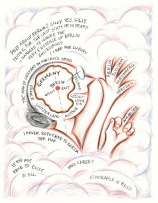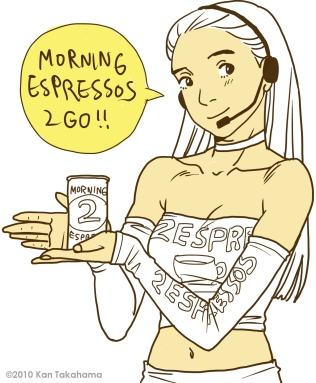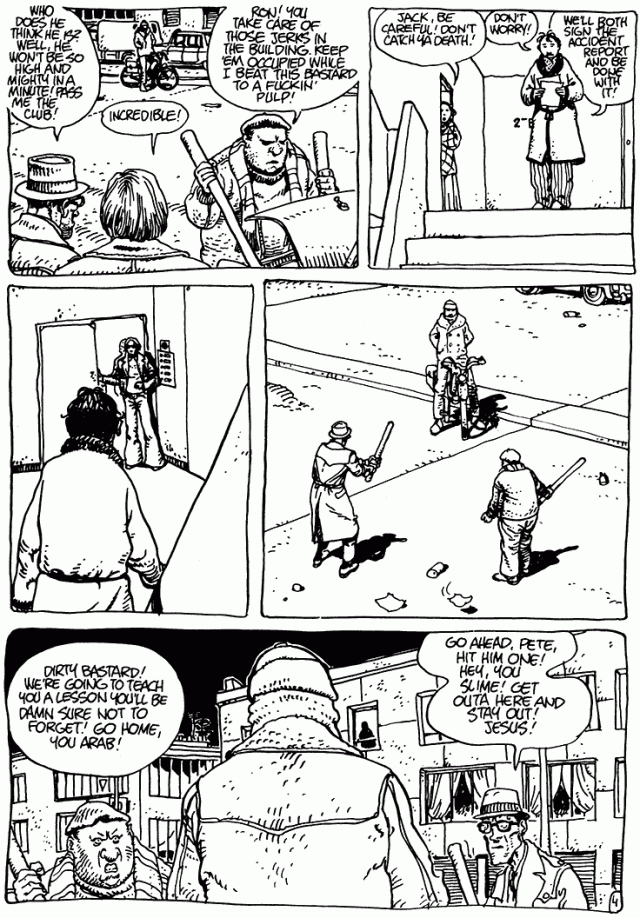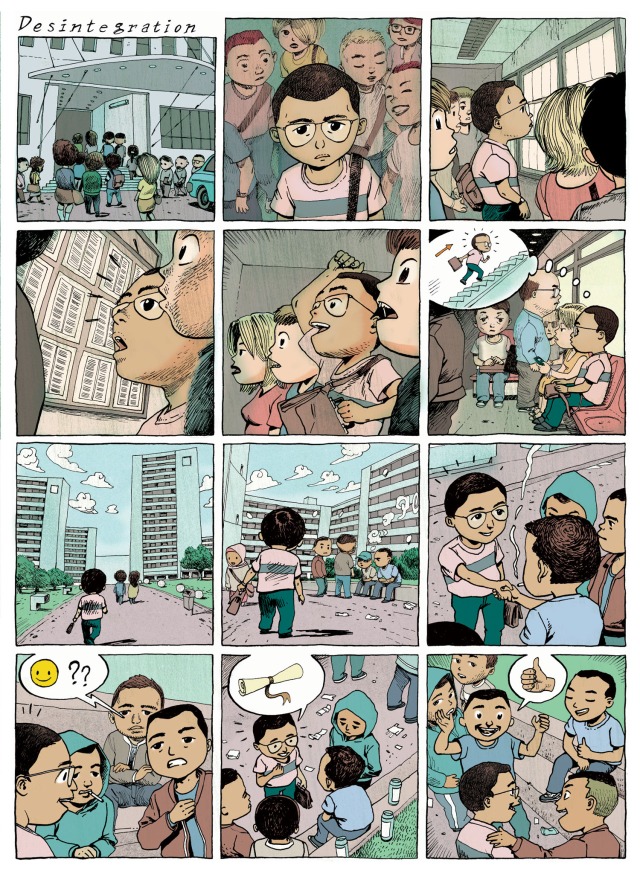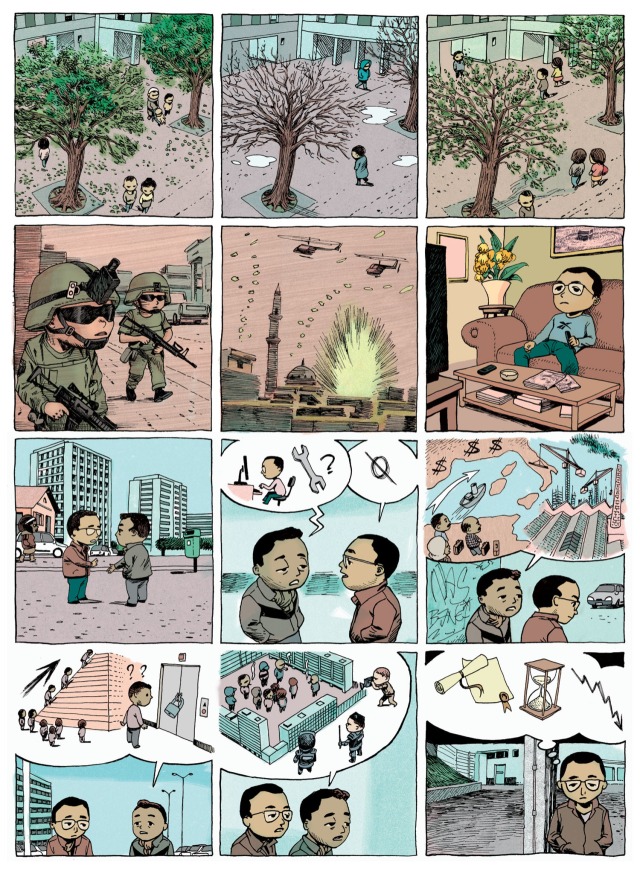[Interview conducted through emails between March and July 2004, initially published in the fourth issue of the zine XeroXed, Multi BD bookstore (Brussels, Belgium). First English publication on du9.org. With some ‘extra content’ at the end of this new publication.]
With Daddy’s Girl [Fantagraphics, 1996], Debbie Drechsler wrote an outstanding graphic novel. For Richard Sala, one of its many qualities is to be seen in the fact that Debbie, not being too well-versed in the history of comics, didn’t impose any limitations on herself or the form while she wrote about a topic as difficult as child abuse. She was able to see a potential that those who’ve worked a lifetime in the field didn’t.
Visitors in the Night, the inaugural short story of Daddy’s Girl, is available on this page.
NICOLAS VERSTAPPEN : How would you introduce yourself ? As an illustrator doing comics on the side, as a comic artist earning her living thanks to illustrations or as another category ?
DEBBIE DRECHSLER : Well, currently I’m an illustrator who used to do comics. I started out as an illustrator then began doing comics when I found myself feeling stifled creatively, in my illustration work. Then I got burned out working on comics — seemed like I had to work every free moment of every day to get them done, and still not on time.
NV : Did you ever thought about doing scripts only ? What about working as a writer ?
DD : I have thought about both — I don’t think I could ever write a script and hand it over to another artist ! Too much of a control freak am I for that ! I don’t know if I could write without drawing but do think about it. And now, I’ve found some kinder, gentler ways to satisfy my creative urges.
NV : What would be those ways ? Painting ?
DD : No, I work with fiber. I started knitting years ago and now spin my own yarns and am learning to weave. I’ve always loved fiber and fabric and find working with the fibers themselves to be meditative and fascinating. It never ceases to amaze me to start out with a pile of fluff and end up with an article of clothing or an object !
NV : As Richard Sala and Lynda Barry aren’t well known in Europe (except for some stories in RAW and BLAB !), could you explain their impact on your professional and artistic career ?
DD : Before I saw either of their work, I didn’t really think of comics in terms of art. Sad but true. I saw Lynda’s work first and she squashed that notion completely ! Also, the content of her work spoke to me more than anything in comics or any other art form. It was funny and personal. She told moving stories with great economy. That gave me a new respect for the idea of comics as an art form. Seeing Richard’s work, and talking with him about it added fuel to that fire. He had started out as a painter and moved to comics.
NV : You jumped between comics and illustrations back and forth as a relief. How would you explain that big distance that separates the style of your comics’drawings and the one of your illustrations drawings ?
DD : That’s easy ! The drawings for each serve entirely different functions.
In comics the artwork is part of the story and needs to be more literal as it’s more informative. Part of the story is told in the pictures so they have to be more explicit. The illustration art is meant to be more decorative — to attract the reader’s attention to the story but not give too much away. So I make them more symbolic and suggestive. Also, it’s function on the page is much different. It’s an oasis in a sea of type, so I use colour and simpler shape to attract attention.
NV : How come you changed your name into “Lily’s” for the Daddy’s Girl collection ? Was it getting from “autobiography” to “autofiction” ?
DD : I just changed it in one story, I think ; Visitors In the Night [short story first published in Drawn & Quarterly Vol.1, #10, 1992]. I’d realized that if I wrote straight autobiography the stories would suffer, so I began to take things that had actually happened and expand upon them, and mold them into stories that worked better than the “honest truth” could (in my opinion). I needed the characters to be fictional to feel comfortable doing that.
NV : Did you find a relief in the writing of Daddy’s Girl or is it an illusion to think that autobiography can ease the pain ?
DD : It worked for me.
NV : It seems important to have an external testimony of what happened during your childhood. The first and the last part of Daddy’s Girl introduce a witness. Do you feel like Craig Thompson saying to his brother in Blankets : “And that’s my comfort… that someone else was there and experienced the same thing. How else could I know it was REAL, and not merely a dream ?”
DD : Yes, it is.
NV : Did you gather in the Daddy’s Girl collection all the short stories you wrote on the subject ? Was it a hard time to get all the pieces of that storyline together ?
DD : Not sure what you’re asking here, but those stories were written over the period of a year, and published in two alternative newspapers in the US, The New York Press and The Stranger, in Seattle. And when I wrote them I really was thinking of them as a long story but subjugating them to the weekly format they were being published in.
NV : Was it obvious for you and the publisher to keep a mixing of pages in colour and black & white ? It may seem a challenge for an alternative publisher…
DD : Well, again, the stories were pre-existing and we both wanted to publish them as they already existed (although we had to change some to fit the pages).
NV : Daddy’s Girl has an “organic” impact thanks to its mixing of techniques (b&w, colours, bichromy) and styles (going back and forth between 1992 and 1996). Daddy’s Girl was also written in a trance-like state. Were you apprehensive about starting Nowhere [5-issue series published by Drawn & Quarterly between 1996 and 1999, later collected as The Summer of Love, D&Q, 2002], knowing you would keep a straighter line ?
DD : I wasn’t apprehensive, but it was a different experience. I had to work harder to find the story and to keep the pace of it. And it was my sophomore work. I was thinking more, in general, about what I was doing and who would be reading it and what they would think of it, than I had with the work in Daddy’s Girl.
NV : What led you to change the title Nowhere into The Summer of Love ? Was it going from a (no) place to a duration, going more “atmospheric” ?
DD : Originally, I was thinking of Nowhere as the name of a comic book series and Summer of Love as one of the stories in that series. But the series never continued.
NV : Why did you change the colours of Nowhere for its collection in The Summer of Love ? Will you keep those colours for the French version ?
DD : Sigh. Those darn colors ! Simply because they never really worked. I came from a graphic design background where pantone colors were what you used all the time. Unfortunately, the comic printers and publishers weren’t familiar with using them and we had difficulty communicating about them. I changed the colors in an effort to make them easier to look at but it didn’t work. I’m hoping to go back to the original comic book colors for the French version [L’Association, 2004].

Fron the French edition

Cover of the French edition

From the French edition
NV : That way of colouring is quite unusual. Is it linked to your interest in fine arts and printmaking ? Some European expressionists from 1910-1920 did use that kind of effect (especially through wood engravings like Wassily Kandinsky for Der Blaue Reiter or Erich Heckel for his Autoportrait). Woodprints can really give that nice effect.
DD : As I said above, it really came from my graphic arts background. Prior to the use of computers for all things graphic, it was customary to save money by using two or three colors rather than 4 color printing. Often, a client would want something in color but only have money for 2 colors instead of 4. If you were an illustrator or designer you knew those pantone numbers by heart !
NV : Are there other painters that have an influence on your work, that are an inspiration ?
DD : Yes, many ! Raoul Dufy, Milton Avery, Maxfield Parrish, Gustav Klimt, Ben Shahn, Antonio Frasconi (a printmaker), Käthe Kollwitz (also printmaker), Wanda Gág, Adolf Dehn, Georgia O’Keefe, and Charlotte Salomon, a young woman who did an amazing series of paintings of her life before she was killed by Nazis in France [complete series here: (Leben? oder Theater?)]. Those are the ones I can think of without making my brain work too hard !
NV : There’s an interesting way in The Summer of Love to work on the third dimension (and I’m not talking about those 3-D jokes !!!). You’re working like Henri Matisse during the period he wanted to make the second and the third dimension fit together. He used a real good sense of perspective but that he would deny in an abusive use of 2-D surfaces (through wallpapers and printed-patterned material). What’s your relationship to those motives you apply on textiles and walls you seem to enjoy ?
DD : As an artist I have a tendency to get too caught up in “making it realistic”. As a result I’ve spent most of my artistic career trying to fight that urge ! Because if I don’t my work gets fussy and boring to look at (and boring to do !). So I like to play with how much I can rearrange
The laws of physics in my pictures and still make them feel “real” or right. And those patterns that I put all over the place — -when I was a kid I used to love going to paint stores and looking through the wallpaper books. I loved the patterns and I loved how they’d show them in different colorways. Also, I’ve always worked with fiber. I learned to sew when I was very young and over time have learned knitting and crochet. I now make my own yarns and threads, and am learning to weave. I love that stuff !

Cover of the first American edition

From the American edition
NV : I have the feeling that The Summer of Love is working as a classical play in five acts. Did its prepublication in five parts influence your writing ?
DD : Well, sure. I wanted each “chapter” to work on it’s own but also make the reader anxious to go on to the next one. And I wrote it one chapter at a time, without planning it all ahead. I’ll never do that again, though ! I wrote myself into some serious plot holes as I went along. If I do another story like that I’ll plot it all out from the beginning !
NV : Did you ever see that as an unconscious way of putting yourself in a creative urge ? Wasn’t it some kind of need to have a relationship of conflict with your comics ?
DD : Nah,got enough of that relationship of conflict with the story already. It was inexperience and bad planning. I’ve never been the kind of person who has to make things uncomfortable in order to do them !
NV : Why did you keep the Meier family in The Summer of Love ? Was it to start directly with more depth (like the glance and silence of Lily when her father comes in the kitchen – page 7) ? Is it to play with a mirror effect (in Daddy’s Girl, Pearl discovers the incest secret of her sister in her diary and help her, in The Summer of Love, Lily discovers the homosexuality secret of her sister and defends her) ?
DD : Really, it was because I found it worked better for me to have familiar characters to work with, and because I wasn’t done with them yet.

From “Ink Spots”, Debbie Drechsler’s first (self-published) graphic narrative

From “Ink Spots”, Debbie Drechsler’s first (self-published) graphic narrative

From “Ink Spots”, Debbie Drechsler’s first (self-published) graphic narrative

From “Ink Spots”, Debbie Drechsler’s first (self-published) graphic narrative

From “Ink Spots”, Debbie Drechsler’s first (self-published) graphic narrative

Cover of “Ink Spots”, Debbie Drechsler’s first (self-published) graphic narrative
NV : Another feeling I have is the strong “fable” subtext in The Summer of Love. We find the classical young female character discovering a new place as Dorothy in Oz, Alice in Wonderland or Wendy in Neverland. Lily could be a (less eroticized) “Lost Girl” as Melinda Gebbie and Alan Moore envision them in their Kitchen Sink comics. Can we see her as Lily in “Woodland” (or in “Nowhere”) discovering her desire through a travel in the woods (even accompanied by the Pied Piper on page 41) ?
DD : The nice thing about stories is that the reader can see whatever they want in them ! The woods were an important place for me as a child. They gave me another world to escape to and that’s what’s important to me and what I consciously put in the story.
NV : How did you work on the characters of The Summer of Love ? Did they come by themselves as uninvited ? Did they come with a well defined personality or as archetypes ? (Personal note : Steve Farley looks like an embodiment of the woods : he first appears in the woods, among the trees, being mysterious and secretive as the forest behind his impenetrable glasses. The cover emphasizes that).
DD : The characters all started out resembling someone in my real life and then took on lives of their own as the story progressed. To Lily, boys were mysterious, unfathomable creatures. Attractive, but they seemed entirely out of her reach. Steve Farley was the embodiment of that.
NV : Do you think those characters will keep haunting you in a third story or will you try to work on new ones ?
DD : One of the reasons I haven’t found a new story is that I believe I’ve finished that one. That burning desire to get them on paper has burned out. If I do another it will be with other characters. But, so far, no characters have reached out to grab me and say, “Me ! I’m next !”
Extra Content
A tribute – published here in its original English version for the first time – by American cartoonist Richard Sala. The text, as a French translation, was originally (written for and) published in the zine XeroXed #4: Debbie Drechsler, Multi BD bookstore, 2004.
DEBBIE AND DADDY’S GIRL
I met Debbie sometime in the mid 1980s at the San Francisco Chronicle. I was dropping off an illustration assignment and she was working there as a staff artist. We were already aware of (and liked) each other’s work. We began going out to lunch sometimes when I’d drive into San Francisco from Berkeley to drop off artwork. We shared a similar aesthetic, we both had backgrounds in the fine arts (not common for illustrators) and although we were always grateful for whatever illustration work we could get, there was a feeling I think we shared – a frustration that were weren’t working up to our potential. It can be very aggravating – the life of an illustrator.
The art directors (most of whom have no actual art experience whatever) always think they know better than you and the editors (who are often extremely unimaginative visually)) always think that they know better than the art directors.
I had begun doing comics a couple of years earlier as an outlet for my more creative impulses. I was a lifelong comics fan and a frustrated writer, so for me, comics were the perfect solution to creative atrophy. By the time I met Debbie, my comics had been printed in Art Spiegelman’s RAW and other anthologies. Debbie was interested in comics, but seemed apprehensive about the form. Storytelling wasn’t her forte, she seemed to feel, and she knew very little about the field. However, she was intrigued, so I encouraged her. And after seeing a little promotional booklet she did called “InkSpots” it was crystal clear to me that she was a natural cartoonist. We had discussed our mutual unhappy childhoods/lives, although without too much detail, and I told her that my comics were a bit like an exorcism for me. I did dark, metaphorical fables, influenced by horror stories and Kafka. These were what would rise to the surface whenever I sat down to write.
It turned out that not only WAS Debbie a natural cartoonist, the story she chose to tell, a true story of her childhood, was more disturbing than any fictional fever dream I ever came up with.
“Visitors in the Night” – or “Daddy’s Girl” as the book was eventually called – is a masterpiece of horror. And it’s all the more horrifying because it is true, and because the actions depicted, the innocence-killing, soul-destroying actions, are happening right now, everyday, all around the world. Now, the story itself is certainly nothing new. In fact, during the 1990s in the US there was so much attention to the awful facts of child abuse that it almost reached a level of hysteria.
However, what makes Debbie’s story so original and so chilling are two things: First, the structure is completely different from the way stories of child abuse are usually told. In those stories, the abuse is usually the “shocking” climax, or the “reveal” (as Hollywood types are fond of calling it these days), the buried secret, the motivation for a character’s actions or whatever. In Debbie’s story, the initial scene of abuse happens near the beginning and is depicted in an almost matter-of-fact manner. It’s an unexpected and horrifying scene, but then we follow the little protagonist through the rest of the night and into the next day. There is no sermonizing, no hysteria, no false self-righteousness. It is simply this little girl’s life — and that is dark, dark, dark.
The second factor is Debbie’s art for the story: The drawings of the characters with their big, hopeful (yet somehow doomed) eyes, and the topsy-turvy space they inhabit – floors rising to hit the reader in the eye, rooms which seem alive, not so much expressionistic as sea sick. Her drawings depict the feeling of innocence stolen, of a pure vision corrupted, of a sweetness that turns to nausea. They are heart-breaking.
I think it can safely be said that there had never been a comic strip like this before “Daddy’s Girl”. Possibly it’s because Debbie, not being too well-versed in the history of comics, didn’t impose any limitations on herself or the form. Perhaps she was able to see a potential that those who’ve worked a lifetime in the field don’t.
In one powerful scene in the story, the little protagontist unexpectedly vomits after eating a cookie. It’s shocking, yet oddly cathartic. In a way I think it’s a very personal, even metaphorical, moment. After all there are some things that just can’t be held in, that just have to come out. And it is the rare artist who can bring something to light in a way that hasn’t been seen before. Debbie is one of those rare artists.
Richard Sala, July 2004


































































































